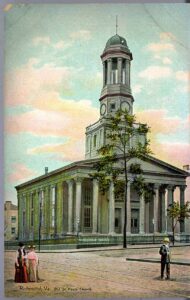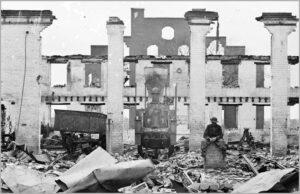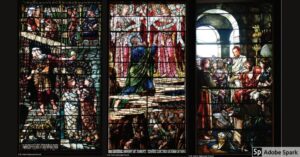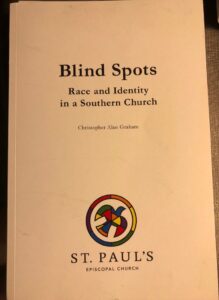ST. PAUL’S EPISCOPAL CHURCH TIMELINE
1811: Monumental Episcopal Church in Richmond, Virginia was planned as a memorial to the devastating Richmond Theater fire on December 26 that took the lives of seventy-two persons.
1814 (May 4): The first service was held in Monumental Church.
1843: Organization of St. Paul’s Episcopal Church began. A cornerstone was placed.
1845: St. Paul’s Church was consecrated.
1859: The General Convention of the Episcopal Church was held in Richmond Virginia.
1861 (April 17): Virginia seceded from the Union.
1861: The Protestant Episcopal Church in the Confederate States of America was formed.
1862: The President of the Confederate States of America, Jefferson Davis, became a member of St. Paul’s Church.
1865 (April 3): Jefferson Davis was informed that Confederate forces were unable to defend Richmond and ordered a fire to be set in the city that would destroy potential supplies for advancing Union forces.
1890s: Family members often were memorialized in St. Paul’s Episcopal Church with Confederacy-themed wall plaques in the sanctuary.
2013: The loosely coupled groups constituting the Black Lives Matter movement emerged following the shooting death of African-American teen Trayvon Martin the previous year and the acquittal of George Zimmerman in a criminal trial.
2015 (June 17): Dyllan Roof killed nine African-American parishioners during a Bible study at the Emanuel African Methodist Episcopal Church in Charleston, South Carolina.
2015: The Episcopal Church’s General Convention passed a resolution that called for the universal discontinuation of display of the Confederate Battle Flag. St. Paul’s removed its Battle Flags.
2015: St. Paul’s Church announced the History and Reconciliation Initiative following the Dylann Roof murders.
2018 (August): Violence erupted in Charlottesville, Virginia at a rally of white nationalists opposed to the removal of a statue of General Robert E. Lee.
2020: St. Paul’s Episcopal Church celebrated its 175th anniversary.
2021: The Washington National Cathedral announced that stain-glass windows depicting Confederate Generals Robert E. Lee and Stonewall Jackson would be replaced with works related to social justice by renowned artist Kerry James Marshall.
2021 (June 25): The Executive Council of the Episcopal Church General Convention announced the formation of a new international, churchwide racial truth and reconciliation effort at its annual meeting.
2022: A “Stations of St. Paul’s” liturgy and art installation acknowledging the church’s history of complicity in slavery and systemic racism was placed on view at the church.
2022: St. Paul’s published a plan for continuing it History & Reconciliation Initiative.
FOUNDER/GROUP HISTORY

The history of St. Paul’s Episcopal Church [Image at right] can be traced to the formation of Richmond’s Monumental Episcopal Church (St. Paul’s Episcopal Church n.d.). Monumental was planned as a memorial to the devastating Richmond Theater fire on December 26, 1811 that took the lives of seventy-two persons. At the time it reportedly was the largest urban disaster in American history. Monumental held its first service three years later on May 4, 1814. Church membership slowly declined, however, as Richmond’s population began migrating westward. A segment of the Monumental membership began planning for what became St. Paul’s (along with St. James’s in 1831 and All Saints in 1888). The cornerstone was laid in 1843, and the church was consecrated two years later just west of the Virginia State Capitol.
During its early years, the St. Paul’s congregation consisted primarily of upper status whites, such as bankers and industrialists, with a small number of black men and women also attending services. It was only fifteen years after its founding that St. Paul’s was swept up in the Civil War, and it from this period that the church became popularly known as the Cathedral of the Confederacy. As Griggs (2017:42) notes:
Of all of Richmond’s churches, none was more closely associated with the Southern Confederacy than St. Paul’s. President Jefferson Davis worshipped there, as did Robert E. Lee when he was in Richmond….On many Sundays, St. Paul’s was filled with soldiers in gray and many women dressed in black to symbolize that they had lost a loved one.
Davis became a member of the congregation in 1862. It was Episcopal Bishop John Johns who baptized Jefferson Davis in the Executive Mansion of the Confederacy and confirmed him in St. Paul’s Episcopal Church. Most of the St. Paul’s congregation at that time were involved in the slavery economy in some fashion.
It was following the Virginia Convention of 1861, which resulted in a convention vote (April 17) and a confirming public vote (May 23), that Virginia seceded from the Union and joined the Confederacy. In the case of the Episcopal Church, the division also began in 1861, when the southern component became the Protestant Episcopal Church in the Confederate States of America. A sermon preached on Thanksgiving Day 1861 at St. John’s Episcopal Church in Richmond clearly linked the church to secession (Stout 2021):
God has given us of the South today a fresh and golden opportunity—and so a most solemn command—to realize that form of government in which the just, constitutional rights of each and all are guaranteed to each and all. … He has placed us in the front rank of the most marked epochs of the world’s history. He has placed in our hands a commission which we can faithfully execute only by holy, individual self-consecration to all of God’s plans.
Events on April 3, 1865 signaled an impending conclusion to the Civil War. Reportedly, while in attendance at St. Paul’s, Jefferson Davis was informed that Confederate forces were unable to defend Richmond any longer. Davis left the church and ordered what  became known as “the fire” [Image at right] be set in the city of Richmond to destroy supplies potentially useful to advancing Union forces. However, the fire raged out of control, ultimately destroying about 800 buildings in the city. The railroad bridge across the James River was also burned to slow the Union army advance (Slipek 2011). Just six days later, on April 9, General Robert E. Lee surrendered his forces to General Ulysses S. Grant at the Battle of Appomattox Court House in Appomattox County, Virginia, effectively ending Civil War combat. The national reintegration of the Episcopal Church occurred soon after the end of the war in 1866, with Bishop John Johns leading the campaign for reunification.
became known as “the fire” [Image at right] be set in the city of Richmond to destroy supplies potentially useful to advancing Union forces. However, the fire raged out of control, ultimately destroying about 800 buildings in the city. The railroad bridge across the James River was also burned to slow the Union army advance (Slipek 2011). Just six days later, on April 9, General Robert E. Lee surrendered his forces to General Ulysses S. Grant at the Battle of Appomattox Court House in Appomattox County, Virginia, effectively ending Civil War combat. The national reintegration of the Episcopal Church occurred soon after the end of the war in 1866, with Bishop John Johns leading the campaign for reunification.
For much of St. Paul’s history following the Civil War the guiding narrative for the church implicitly or explicitly involved racial inequality/slavery and what is termed “Lost Cause” mythology. Like many other Protestant denominations in the South, Episcopal churches accepted versions of Christianity that legitimated slavery. The Lost Cause mythology contained several key elements (Wilson 2009; Janney 2021):
At the center of the myth is the assertion that secession was not about slavery at all; rather, secession was a constitutionally legitimate process, a protection of states’ rights, and a defense of agrarian southern culture against the northern infidels. The Confederacy preferred to refer to the Civil War as the War between the States. Secession was an institutional right of every state. In that sense secession was in many ways akin to the original American revolution as a fight against tyranny.
The Lost Cause narrative gained momentum toward the end of the nineteenth century nationally, but it was particularly notable in Richmond and among Episcopalians. Episcopalians were prominent in the support for the Lost Cause, due to “…their position in Southern society: the Episcopal church was the church of the antebellum planter class” (Wilson 2009:35). At St. Paul’s, it became popular during the 1890s to memorialize family members with wall plaques in the sanctuary, some of which featured memorial wall plaques, alter kneelers, and Confederate battle flags (Doyle 2017; Kinnard 2017). The church erected memorials to Robert E. Lee and Jefferson Davis in the 1890s and embraced the“Lost Cause”  narrative of the Civil War (Wilson 2009:25). [Image at right] In an 1889 mural, for example, a youthful Moses is presented in a way that resembles Robert E. Lee as a young officer in the Confederacy (Chilton 2020). The accompanying inscription read:“By faith Moses refused to be called the son of Pharoah’s Daughter choosing rather to suffer affliction with the Children of God for he endured as seeing Him who is invisible. In grateful memory of Robert Edward Lee born January 19 1807.”
narrative of the Civil War (Wilson 2009:25). [Image at right] In an 1889 mural, for example, a youthful Moses is presented in a way that resembles Robert E. Lee as a young officer in the Confederacy (Chilton 2020). The accompanying inscription read:“By faith Moses refused to be called the son of Pharoah’s Daughter choosing rather to suffer affliction with the Children of God for he endured as seeing Him who is invisible. In grateful memory of Robert Edward Lee born January 19 1807.”
That cultural tradition persisted through the mid-twentieth century. As the chair of the church’s History and Reconciliation Initiative commented, “ St. Paul’s remained steeped in Lost Cause lore through the Jim Crow era,” that is, between the 1870s and 1960s (Williams 2018).
Even during the first decade of the twenty-first century, public celebration of the Confederacy and its leaders was still highly visible in Virginia (Feld 2020). In 2006, there was overwhelming legislative support for state authorization of license plates honoring Robert E. Lee. In 2007, a bill titled “Authorizes the Commissioner of the Department of Motor Vehicles to issue special license plates honoring Robert E. Lee” unanimously passed both houses of the Virginia state legislature.
The roots of the Episcopal Church’s initial inquiry into its role in racial oppression can be traced at least to initiatives by its Black caucus in the 1960s (Paulsen 2021). However, it was in 2006 that the Episcopal Church began to take action. In 2006, the General Convention of the Episcopal Church passed a resolution acknowledging its participation in slavery and segregation:
Resolved, That we express our most profound regret that (a) The Episcopal Church lent the institution of slavery its support and justification based on Scripture, and (b) after slavery was formally abolished, The Episcopal Church continued for at least a century to support de jure and de facto segregation and discrimination;
Following this resolution, Episcopalian dioceses across the country (Georgia, Texas, Maryland and Virginia) began programs in response to the resolution. Other predominantly white denominations, such as the Presbyterian Church (2004) and the Evangelical Lutheran Church (2019) passed similar resolutions and initiated denominational and inter-denominational response programs (Moscufo 2022).
Several key events contributed to St. Paul’s and other institutions reassessing their racially freighted histories. In 2013, the loosely coupled groups constituting the Black Lives Matter movement emerged following the shooting death of African-American teen Trayvon Martin the previous year and the subsequent acquittal of George Zimmerman in a criminal trial. In 2015,  Dyllan Roof killed nine African-American parishioners during a Bible study at the Emanuel African Methodist Episcopal Church in Charleston, South Carolina. [Image at right] It was just a few months after that shooting that systematic removal of Confederate-themed relics began. That year the Episcopal Church’s General Convention passed a resolution that called for the universal discontinuation of display of the Confederate Battle Flag: “The Episcopal Church strongly urges all persons, along with public, governmental, and religious institutions, to discontinue the display of the Confederate Battle Flag.” In Richmond, shortly after the Dyllan Roof murders, the Rev. Wallace Adams-Riley, St. Paul’s rector, asked in a sermon, “What if in this, the last summer of the sesquicentennial of the American Civil War, we begin a conversation here at St. Paul’s about the Confederate symbols in our worship space?” (Doyle 2017). St. Paul’s sought to distance from its popular sobriquet as The Cathedral of the Confederacy (Noe-Payne 2015; Millard 2020):
Dyllan Roof killed nine African-American parishioners during a Bible study at the Emanuel African Methodist Episcopal Church in Charleston, South Carolina. [Image at right] It was just a few months after that shooting that systematic removal of Confederate-themed relics began. That year the Episcopal Church’s General Convention passed a resolution that called for the universal discontinuation of display of the Confederate Battle Flag: “The Episcopal Church strongly urges all persons, along with public, governmental, and religious institutions, to discontinue the display of the Confederate Battle Flag.” In Richmond, shortly after the Dyllan Roof murders, the Rev. Wallace Adams-Riley, St. Paul’s rector, asked in a sermon, “What if in this, the last summer of the sesquicentennial of the American Civil War, we begin a conversation here at St. Paul’s about the Confederate symbols in our worship space?” (Doyle 2017). St. Paul’s sought to distance from its popular sobriquet as The Cathedral of the Confederacy (Noe-Payne 2015; Millard 2020):
We are not and do not wish to be identified with white supremacy, or Lost Cause theology. The St. Paul’s of today is a diverse church community open and welcoming to all (Virginia Foundation for the Humanities 2017).
The process began with discussion about which of the numerous Confederacy-themed artifacts should be removed. Initially, stained glass windows were preserved. The church vestry voted to remove the battle flags in November 2015. Subsequently, kneelers with the Confederate flag in needlepoint were removed and the church’s coat of arms was retired. By 2020, the church decided to remove or rededicate all of its remaining Confederate memorials (Kinnard 2017; Chilton 2020).
There was, of course, a much broader movement to remove Confederate symbols that was similarly fraught. Numerous other Virginia churches, including the R.E. Lee Memorial Episcopal Church in Lexington, encountered sometimes intense engagement and conflict during this period, as did public colleges and universities across Virginia (Cumming 2018; Anderson and Svrluga 2021). A major development occurred in 2020 when the mayor of Richmond ordered the immediate removal of all Confederate themed statues on public property (Wamsley 2020).
DOCTRINES/RITUALS
St. Paul’s has embraced two distinct identities through its history. In recent years it has sought to exchange its earlier identity as the Cathedral of the Confederacy for its current promise to become the Cathedral of Reconciliation. Symbolically, this transformation begins with its open acknowledgement of its historical involvement in racial oppression and Lost Cause mythology (Saint Paul’s Episcopal Church n.d.):
We are part of a living and evolving history. Our story began in 1844 as the United States’ economic and political structures fully embraced racial slavery. The resources that made this church possible came directly from the profits of factories and businesses, built on the backs of enslaved African American people. During those years, many white Protestants sought to justify slavery as God’s plan. St. Paul’s members also supported, along with most proslavery Protestants, a theology that insisted that God ordained racial inequality and that, as white people, they had a responsibility to govern black people. St. Paul’s became inextricably entwined with the Confederacy during the American Civil War. It was the home church to Confederate officials and officers and the scene of dramatic events at the end of the conflict. In the aftermath of the Civil War, St. Paul’s officially recognized its connections to Robert E. Lee, who worshipped here, and Jefferson Davis, who was baptized as a member of the parish, by marking their pews and installing windows in their honor.
Juxtaposed to this acknowledgement is its vision of a mission to “Proclaim Christ in the Heart of the City.” That mission involves openness, equality, service, community, and active engagement (St Paul’s Episcopal Church n.d.):
Welcoming all to join us in worship and ministry.Respecting the dignity of every human being.
Seeking and serving Christ in all people, loving our neighbors as ourselves.
Growing as a community of God’s people by reaching out to others.
Being active in the world as witnesses of God’s love.
Pledging ourselves to compassion and service by supporting one another in local, national, and international ministries.
ORGANIZATION/LEADERSHIP
St. Paul’s is part of the worldwide Anglican Communion and one of three dioceses in Virginia. It is a moderate-sized congregation. Its active membership is 300-400, with about half of the active membership participating attending Sunday services (Doyle 2017). When the church began its History and Reconciliation Initiative, about 100 members initially participated.
The Richmond Metropolitan Area has increased in size and diversity in recent decades and has become less conservative (Weinstein 2022). This more progressive stance has been reflected in some religious congregations, and notably in St. Paul’s. Beginning in the 1970s, St. Paul’s undertook dozens of initiatives intended to alleviate the legacies of racism and segregation in Richmond, including the funding for public health, educational, and fair housing projects. (Doyle 2017; St. Paul’s n.d.). Although church membership continues to be predominantly white, racial diversity in leadership positions has changed substantially (St. Paul’s Episcopal Church 2022). The History and Reconciliation Initiative has become a focal point of church activity since 2015.
ISSUES/CONTROVERSIES
The evolution of the conflict over Confederate-themed symbols, plaques, names, holidays, statues, and buildings continues as do activities on both sides. For example, in 2018 lethal violence erupted in August 2018 in Charlottesville at a rally of white nationalists opposed to the removal of a statue of General Robert E. Lee. Confederate paraphernalia was present at the January 6, 2021 political insurrection in Washington, DC. At the same time removal or Confederate objects and symbols has continued apace across the nation. In 2020, 168 objects and symbols were removed across the country, with Virginia recording the most (McGreevy 2021). The removals, of course, left unanswered what would replace them, and in Richmond the Virginia Museum of the Fine Arts was tasked with leading the development of proposals for repurposing the sites. In one case of replacement, a bill passed both state legislative bodies replacing the Lee-Jackson Day holiday with an Election Day holiday (Stewart 2020).
The Episcopal Church moved ahead with its truth and reconciliation project. In June 2021, the Executive Council of the Episcopal Church General Convention announced the formation of a new international, churchwide racial truth and reconciliation effort at its annual meeting. A working group was formed to develop proposals “that will foster and facilitate the convention’s adoption of a plan and pathway for a process of truth and reconciliation in The Episcopal  Church” (Millard 2021). In Richmond, St. Paul’s History and Reconciliation Project reached a milestone with the presentation of its project report, Blindspots. [Image at right]
Church” (Millard 2021). In Richmond, St. Paul’s History and Reconciliation Project reached a milestone with the presentation of its project report, Blindspots. [Image at right]
IMAGES
Image #1: Monumental Church
Image #2: The Richmond and Petersburg Railroad depot near Eighth and Byrd streets after the evacuation fire of 1865.
Image 3: Stained glass windows in the St. Paul’s sanctuary honoring Robert E. Lee. (Clickable image).
Image #4; Dylann Roof displaying a Confederate flag.
Image #5: The front cover of the History and Reconciliation Project report, Blindspots.
REFERENCES
Anderson, Nick and Susan Syrluga. 2021, “From slavery to Jim Crow to George Floyd: Virginia universities face a long racial reckoning.” Washington Post, November 26. Accessed from https://www.washingtonpost.com/education/2021/11/26/virginia-universities-slavery-race-reckoning/?utm_campaign=wp_local_headlines&utm_medium=email&utm_source=newsletter&wpisrc=nl_lclheads&carta-url=https%3A%2F%2Fs2.washingtonpost.com%2Fcar-ln-tr%2F356bfa2%2F61a8b7729d2fdab56bae50ef%2F597cb566ae7e8a6816f5e930%2F9%2F51%2F61a8b7729d2fdab56bae50ef on 10 May 2022.
Banks, Adelle. 2021. “Cathedral to replace Confederate windows with stained glass reflecting Black life.” Religion News, September 23. Accessed from thehttps://religionnews.com/2021/09/23/cathedral-to-replace-confederate-windows-with-stained-glass-reflecting-black-life/ on 10 May 2022.
Bohland, Jon. 2006. A Lost Cause Found: Vestiges of Old South Memory in the Shenandoah Valley of Virginia. Ph.D. Dissertation, Virginia Polytechnic Institute and State University.
Chilton, John. 2020. “St. Paul’s Richmond to rededicate Lee and Davis windows with new meaning.” Episcopal Café, July 12. Accessed from https://www.episcopalcafe.com/st-pauls-richmond-to-rededicate-lee-and-davis-windows-with-new-meaning/ on 1 November 2021.
Cumming, Doug. 2018. “Our church was named for Robert E. Lee — here is how we changed it.” Religion News Service, January 15. Accessed from https://www.ncronline.org/news/parish/our-church-was-named-robert-e-lee-here-how-we-changed-it on 10 May 2022.
Doyle, Heather Beasley. 2017. “‘Cathedral of the Confederacy’ reckons with its history and charts future.” Episcopal News Service, June 19. Accessed from the https://www.episcopalnewsservice.org/2017/06/19/cathedral-of-the-confederacy-reckons-with-its-history-and-charts-future/ on 10 May 2020.
Feld, Lowell. 2020. “Just 10-15 Years Ago, Virginia Legislators Were Voting Overwhelmingly to Approve “Special License Plates Honoring Robert E. Lee” and to “Defend Marriage.” Blue Virginia, June 18. Accessed from https://bluevirginia.us/2020/06/just-10-15-years-ago-virginia-legislators-were-voting-overwhelmingly-to-approve-special-license-plates-honoring-robert-e-lee-and-to-defend-marriage on 10 May 2022.
General Convention. 2007. “2006 Study of Economic Benefits Derived from Slavery.” Journal of the General Convention of…The Episcopal Church, Columbus. New York: General Convention, pp. 664-65. Accessed from https://episcopalarchives.org/cgi-bin/acts/acts_resolution-complete.pl?resolution=2006-A123 on 10 May 2022.
Griggs, Walter. 2017. Historic Richmond Churches & Synagogues. Charleston, SC: The History Press.
Janney, Caroline. “The Lost Cause. 2021. Encyclopedia of Virginia. Accessed from https://encyclopediavirginia.org/entries/lost-cause-the on 9 November 2021.
Kinnard, Meg. 2017. “Episcopalians struggle with history of Confederate symbols.” Associated Press, September 18. Accessed from https://gettvsearch.org/lp/prd-best-bm-msff?source=google display&id_encode=187133PWdvb2dsZS1kaXNwbGF5&rid=15630&c=10814666875&placement=www.whsv.com&gclid=EAIaIQobChMIl6eUipjp8wIVVcLhCh3mbgFkEAEYASAAEgIG4vD_BwE on 26 October 2021.
McGreevy, Nora. 2021. “The U.S. Removed Over 160 Confederate Symbols in 2020—but Hundreds Remain.” Smithsonian Magazine, February 25. Accessed from https://www.smithsonianmag.com/smart-news/us-removed-over-160-confederate-symbols-2020-more-700-remain-180977096/ on 10 May 2022.
Millard, Egan. 2021. “Presiding Bishop announces new churchwide racial truth and reconciliation effort during first day of Executive Council.” Episcopal News Service, June 25. Accessed from
https://www.episcopalnewsservice.org/2021/06/25/presiding-bishop-announces-new-churchwide-racial-truth-and-reconciliation-effort-during-first-day-of-executive-council/
Millard, Egan. 2020. “As Confederate symbols come down in Virginia, a Richmond church removes its own, but keeps BLM graffiti.” Episcopal News Service, July 9. Accessed from https://www.episcopalnewsservice.org/2020/07/09/as-confederate-symbols-come-down-in-virginia-a-richmond-church-is-removing-its-own-and-leaving-black-lives-matter-graffiti/ on 10 May 2022.
Moscufo, Michela. 2022. “Churches played an active role in slavery and segregation. Some want to make amends.” NBC News, April 3. Accessed from the https://www.nbcnews.com/news/nbcblk/churches-played-active-role-slavery-segregation-want-make-amends-rcna21291?utm_source=Pew+Research+Center&utm_campaign=8092da544f-EMAIL_CAMPAIGN_2022_04_04_01_47&utm_medium=email&utm_term=0_3e953b9b70-8092da544f-399904145 on 10 May 2022.
Noe-Payne, Mallory. 2015. “Richmond’s St. Paul’s Episcopal Church Seeks to Become “Cathedral of caReconciliation.” Radio IQ, November 24. Accessed from
https://www.wvtf.org/news/2015-11-24/richmonds-st-pauls-episcopal-church-seeks-to-become-thedral-of-reconciliation on 10 May 2022.
Paulsen, David. 2021. “Deputies of Color organize for change in Episcopal Church, society ahead of General Convention.” Episcopal New Service, September 24. Accessed from https://www.episcopalnewsservice.org/2021/09/24/deputies-of-color-organize-for-change-in-episcopal-church-society-ahead-of-general-convention/ on 10 May 2022.
St. Paul’s Episcopal Church. 2022. “Our Staff & Leadership.” Accessed from https://www.stpaulsrva.org/staffandleadership on 10 May 2022.
St. Paul’s Episcopal Church. n.d.“History and Reconciliation Initiative.” Accessed from https://www.stpaulsrva.org/HRI on 27 October 2021.
St. Paul’s Episcopal Church. n.d. “More History.” Accessed from https://www.stpaulsrva.org/alittlemorehistory on 10 May 2022.
St. Paul’s Episcopal Church. n.d. “Our Mission and Vision.” Accessed from https://www.stpaulsrva.org/ourmissionandvision on 10 May 2022.
Stewart, Caleb. 2020. “Va. lawmakers pass bills to end Lee-Jackson Day and make Election Day a holiday.” Associated Press, February 6. Accessed from https://www.nbc12.com/2020/02/07/va-lawmakers-pass-bills-end-lee-jackson-day-make-election-day-holiday/ on 10 May 2022.
Stout, Harry. 2021. “Religion in the Civil War: The Southern Perspective.” Accessed from
http://nationalhumanitiescenter.org/tserve/nineteen/nkeyinfo/cwsouth.htm on 18 November 2021.
Virginia Foundation for the Humanities. 2017. “Dealing with the Past from a Theological /Faith-based practice.” Webinar, December 13. Accessed from https://zehr-institute.org/webinars/dealing-with-the-past-from-a-theological-faith-based-practice/ on 16 May 2022.
Wamsley, Laurel. 2020. “Richmond, Va., Mayor Orders Emergency Removal Of Confederate Statues.” NPR, July 1. Accessed from https://www.npr.org/sections/live-updates-protests-for-racial-justice/2020/07/01/886204604/richmond-va-mayor-orders-emergency-removal-of-confederate-statues on 10 May 2022.
Weinstein, Dina. 2022. “Counting Change.” Richmond Magazine, February 7. Accessed from the https://richmondmagazine.com/news/features/counting-change/ on 10 May 2022.
Williams, Michael. 2018. “Richmond church to delve into race’s role in its history.” Richmond Times Dispatch, March 9. Accessed from https://www.pressreader.com/usa/richmond-times-dispatch/20180309/281921658559136 on 1 November 2021
Wilson, Charles. 2009. Baptized in Blood: The Religion of the Lost Cause, 1865-1920. Athens: University of Georgia Press.
Publication Date:
19 May 2022
